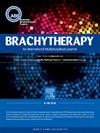了解低级别早期子宫内膜癌患者接受阴道近距离放疗时的焦虑。
IF 1.7
4区 医学
Q4 ONCOLOGY
引用次数: 0
摘要
目的:阴道近距离放射治疗(VBT)是早期子宫内膜癌切除术后的标准治疗方法。尽管只需要几种毒性最小的治疗方法,但许多妇女对VBT有明显的焦虑。本研究旨在评估和量化接受VBT治疗的早期子宫内膜癌患者的焦虑,并评估其与临床病理和人口统计学变量的相关性。方法:通过一项基于调查的队列研究,对2014年至2020年子宫切除术后接受辅助VBT治疗的18-99期I-II期子宫内膜样子宫内膜癌患者进行了调查,以评估VBT的经历和相关焦虑。排除复发性疾病患者。评估包括:(1)定性问卷(测量vbt前后的焦虑和情绪),(2)临床因素问卷(测量健康状况),(3)医院与焦虑抑郁量表(HADS),(4)人口统计学问卷。使用皮尔逊卡方检验将人口统计学与焦虑联系起来。结果:185例患者符合入选标准,其中75例患者完成全部4项调查。49名患者(65%)在接受VBT前报告焦虑或恐惧,与疼痛(40%),生活质量(27%),膀胱/肠功能(24%)相关。在单因素分析中,大学及以上学历、收入≥80,000美元、HADS-Anxiety≥8的患者更容易出现焦虑,X2值分别为4.64 (p = 0.03)、5.79 (p = 0.02)和6.49 (p = 0.01)。只有收入≥80,000美元在多变量分析中接近显著性(p = 0.07)。结论:大多数患者在辅助VBT治疗前经历焦虑。重要的是要增加有关VBT的一般知识,并建立教育工具,以减少VBT相关的焦虑和恐惧。本文章由计算机程序翻译,如有差异,请以英文原文为准。
Understanding anxiety in patients receiving vaginal brachytherapy for low-grade early-stage endometrial cancer
PURPOSE
Vaginal brachytherapy (VBT) is a standard treatment after hysterectomy for early-stage endometrial cancer. Despite only requiring a few treatments with minimal toxicity, many women have significant anxiety regarding VBT. This study was to assess and quantify anxiety in early-stage endometrial cancer patients receiving VBT and to evaluate correlations with clinicopathologic and demographic variables.
METHODS
A survey-based cohort study of patients ages 18–99 with stage I-II endometrioid endometrial cancer treated with adjuvant VBT after hysterectomy between 2014 and 2020 was performed to assess experience with VBT and related anxiety. Patients with recurrent disease were excluded. Assessments included: (1) qualitative questionnaire measuring anxiety and mood pre- and post-VBT, (2) clinical factors questionnaire measuring health status, (3) Hospital and Anxiety Depression Scale (HADS), and (4) demographics questionnaire. Pearson’s chi-squared test was used to correlate demographics with anxiety.
RESULTS
About 185 patients met inclusion criteria and of those, 75 completed all 4 surveys. Forty-nine patients (65%) reported anxiety or fear prior to receiving VBT, related to concerns of pain (40%), quality of life (27%), bladder/bowel function (24%). On univariate analysis, patients with a college degree or higher, income of ≥ $80,000, and HADS-Anxiety ≥ 8 were significantly more likely to experience anxiety with X2 values of 4.64 (p = 0.03), 5.79 (p = 0.02), and 6.49 (p = 0.01), respectively. Only income ≥ $80,000 approached significance on multivariable analysis (p = 0.07).
CONCLUSION
A majority of patients experience anxiety prior to treatment with adjuvant VBT. It is important to increase the general knowledge surrounding VBT and to establish educational tools to reduce VBT related anxiety and fear.
求助全文
通过发布文献求助,成功后即可免费获取论文全文。
去求助
来源期刊

Brachytherapy
医学-核医学
CiteScore
3.40
自引率
21.10%
发文量
119
审稿时长
9.1 weeks
期刊介绍:
Brachytherapy is an international and multidisciplinary journal that publishes original peer-reviewed articles and selected reviews on the techniques and clinical applications of interstitial and intracavitary radiation in the management of cancers. Laboratory and experimental research relevant to clinical practice is also included. Related disciplines include medical physics, medical oncology, and radiation oncology and radiology. Brachytherapy publishes technical advances, original articles, reviews, and point/counterpoint on controversial issues. Original articles that address any aspect of brachytherapy are invited. Letters to the Editor-in-Chief are encouraged.
 求助内容:
求助内容: 应助结果提醒方式:
应助结果提醒方式:


